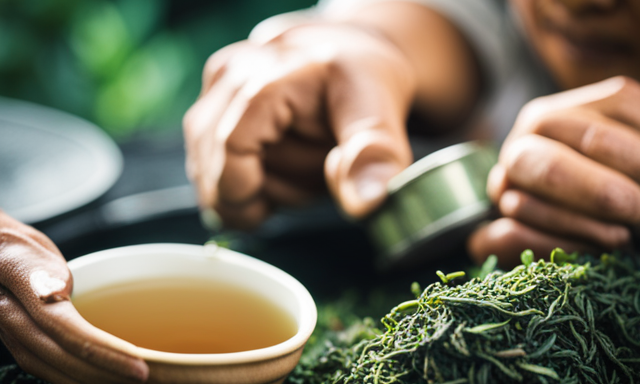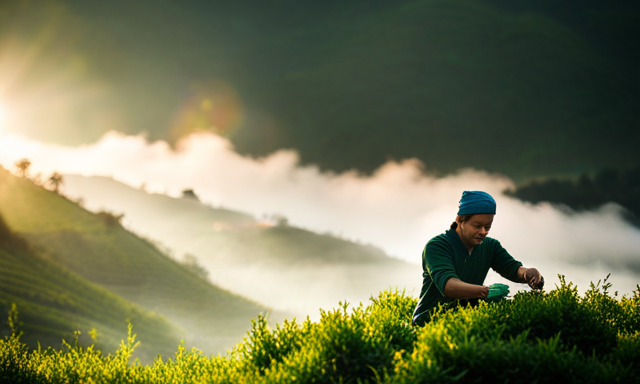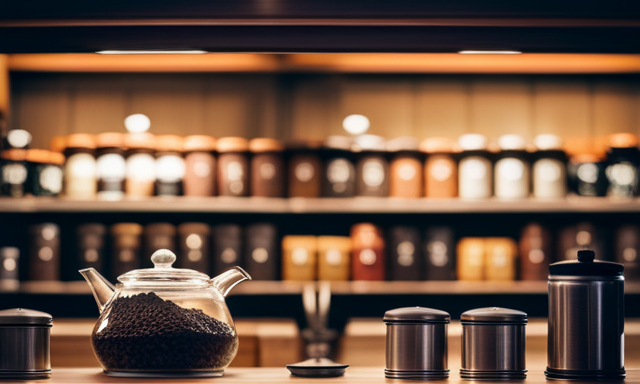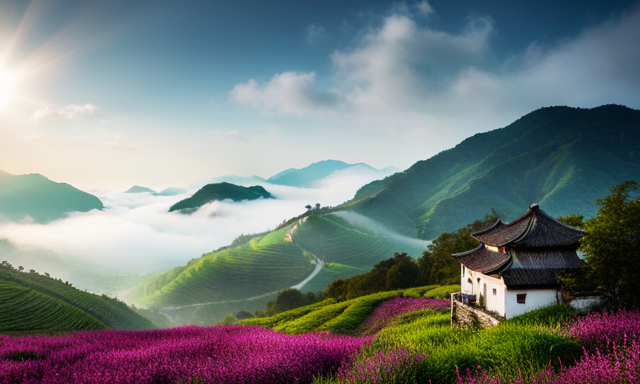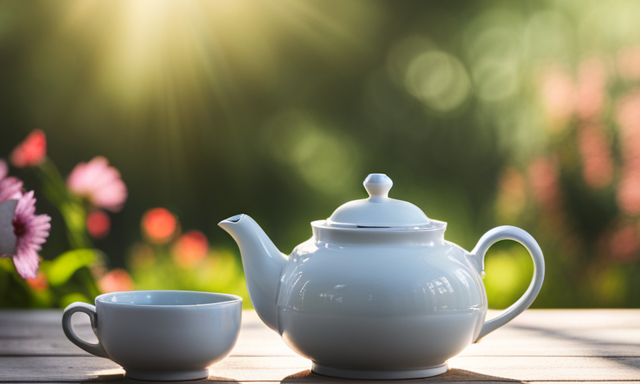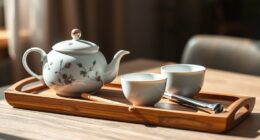While I relax, enjoying a cup of oolong tea, I am amazed by the detailed process that goes into creating this delightful drink.
Like a master craftsman shaping a work of art, the journey of oolong tea begins with the plucking of tender tea leaves from the Camellia sinensis plant.
These leaves then undergo a carefully orchestrated dance of withering, oxidation, fermentation, and firing, each step contributing to the unique flavors and aromas that oolong tea is renowned for.
Once the leaves have been sorted and graded, they are lovingly packaged and stored, patiently waiting to be brewed and savored.
Join me on a journey of discovery as we delve into the fascinating world of oolong tea and learn how this captivating beverage is made.
Key Takeaways
- Oolong tea undergoes a meticulous process of withering, rolling, and oxidation, which gives it a characteristic complexity of flavor.
- Proper packaging and storage are crucial for maintaining the quality of oolong tea.
- Brewing techniques, such as steeping the tea leaves for 2-5 minutes at a water temperature of 190-200°F, unlock the full flavor potential of oolong tea.
- Oolong tea offers a wide range of flavors, from floral and fruity to toasty and nutty, making it a unique and enjoyable sensory experience.
History and Origins of Oolong Tea
Imagine yourself transported back in time to the misty mountains of China, where the rich history and origins of oolong tea unfold before your eyes.
Oolong tea, with its origins dating back centuries, holds great cultural significance in Chinese tradition. This unique tea is believed to have been first produced in the Fujian province during the Ming Dynasty. Its production process involves a delicate balance of oxidation and fermentation, resulting in a tea that falls between green and black tea in terms of flavor and color.
Oolong tea has been enjoyed for generations, not only for its exquisite taste but also for its perceived health benefits. As we delve deeper into the art of oolong tea, let’s explore the meticulous process of plucking the tea leaves, a crucial step in creating this remarkable brew.
Plucking the Tea Leaves
When you pluck the fresh leaves from the tea plant, a world of flavors and aromas awaits. Tea picking is a delicate process that requires skill and precision. Here are four key steps involved in tea harvesting:
-
Selecting the right leaves: Only the top two leaves and the bud are plucked, as they contain the highest concentration of flavor compounds.
-
Timing is everything: The leaves are picked early in the morning when the temperature is cool, ensuring optimal freshness.
-
Gentle handling: The leaves are carefully plucked by hand to avoid damaging them, preserving their quality.
-
Experienced pickers: Skilled tea pickers know how to identify the perfect leaves, ensuring the best flavor and aroma in the final product.
After the tea leaves are plucked, they undergo the withering process, where they are left to wither and lose moisture. This is an essential step in the production of oolong tea as it prepares the leaves for the next stage of processing.
Withering Process
To achieve the best flavor in your cup of tea, you might be thinking that the withering process is just a step that can be skipped, but let me tell you why it’s an essential part of the tea production. During the withering process, freshly plucked tea leaves are spread out and left to wilt for a specific period of time. This step plays a crucial role in reducing moisture content and softening the leaves. Withering techniques vary depending on the type of tea desired. For example, some teas are withered in direct sunlight, while others are withered indoors under controlled temperature and humidity. The benefits of withering include the elimination of grassy and astringent flavors, the development of aromatic compounds, and the enhancement of tea’s natural sweetness. Now, let’s move on to the next stage, which is oxidation and fermentation.
Oxidation and Fermentation
Now, you may be wondering how this next step in the tea production process will transform those withered leaves into a rich and flavorful beverage that’ll awaken your taste buds like never before. This step is called oxidation and fermentation, and it plays a crucial role in the development of oolong tea’s unique characteristics.
1) Aroma: During oxidation and fermentation, the leaves release a captivating aroma that fills the air and entices your senses.
2) Flavor: This process enhances the tea’s natural flavors, creating a complex and multidimensional taste profile that’s both smooth and robust.
3) Health benefits: Oxidation and fermentation also contribute to the tea’s numerous health benefits, including improved digestion, boosted metabolism, and enhanced mental alertness.
4) Antioxidants: These two processes increase the concentration of antioxidants in the tea, which helps combat free radicals and promotes overall well-being.
As we move on to the subsequent section about firing or roasting the leaves, the transformation of the tea leaves continues.
Firing or Roasting the Leaves
After undergoing oxidation and fermentation, the leaves undergo a crucial step known as firing or roasting, which further deepens the flavors and aromas of the final beverage. Firing techniques play a significant role in determining the taste profile of oolong tea. The leaves are carefully heated in a controlled environment to achieve the desired level of roasting, which can range from light to heavy. This process not only stops the oxidation but also enhances the natural flavors of the tea. The firing temperature and duration vary depending on the desired characteristics of the final product. Lighter roasts tend to have floral and fruity notes, while darker roasts develop a rich and toasty flavor. The firing process is a key factor in flavor development, setting the stage for the next step: rolling and shaping the leaves.
Rolling and Shaping
During the rolling and shaping process, the leaves transform into delicate, tightly twisted bundles that resemble tiny scrolls waiting to unfurl their secrets. This step is crucial in creating oolong tea’s distinctive appearance and flavor.
Here are three essential techniques and methods used in this stage:
-
Tumbling: The leaves are placed in a bamboo tray and gently rolled by hand. This action helps to release enzymes, intensifying the aroma and flavor.
-
Wrapping: Skilled tea artisans wrap the leaves in cloth and apply pressure, shaping them into their characteristic twisted form. This technique also allows for the oxidation process to occur more evenly.
-
Curling: Tea leaves are curled by hand or using machines, further enhancing their shape and texture. This process helps to preserve the leaves’ natural oils, resulting in a rich and complex flavor profile.
As the leaves are skillfully rolled and shaped, they prepare for the next step of sorting and grading, where their quality is assessed.
Sorting and Grading
Craftsmen carefully classify and categorize the curled and shaped leaves, assessing their quality through a meticulous sorting and grading process.
Various sorting methods are employed to ensure that only the finest leaves make it into the final product. One method involves visually inspecting each leaf, looking for any imperfections or inconsistencies in size, color, and shape. Another method utilizes mechanical sorting machines that separate the leaves based on their size and weight.
Once the sorting process is complete, the leaves are then graded according to their quality. This grading system takes into account factors such as the leaf’s appearance, aroma, and taste. The highest grade leaves are reserved for premium oolong teas, while lower grade leaves are used for more affordable options.
With the sorting and grading complete, the leaves are now ready to be packaged and stored, ensuring their freshness and flavor are preserved.
Packaging and Storage
To ensure your enjoyment, the next step is carefully packaging and storing these exquisite leaves, preserving their freshness and flavor. Proper packaging techniques and long-term storage methods are essential in maintaining the quality of oolong tea. When it comes to packaging, airtight containers, such as tin cans or vacuum-sealed bags, are commonly used to protect the leaves from exposure to light, moisture, and air. This helps to prevent oxidation and preserve the tea’s delicate aroma and taste. For long-term storage, it is recommended to store the tea in a cool, dark place away from strong odors. Some tea enthusiasts even opt for aging oolong tea, which can enhance its flavor over time. As we move on to the next section about brewing and serving oolong tea, it’s important to understand the significance of proper packaging and storage in maintaining its quality.
Brewing and Serving Oolong Tea
Now that we’ve learned about the packaging and storage of oolong tea, let’s dive into the art of brewing and serving this delightful beverage.
Brewing techniques play a crucial role in unlocking the full flavor potential of oolong tea. It’s recommended to use water that’s around 190-200°F and steep the tea leaves for 2-5 minutes, depending on your personal preference. This’ll result in a perfectly balanced cup of oolong tea, with its unique combination of floral, fruity, and toasty notes.
Not only does oolong tea offer a delightful taste experience, but it also provides numerous health benefits. It’s rich in antioxidants, boosts metabolism, aids digestion, and promotes healthy skin.
So, brew yourself a cup of oolong tea and savor its exquisite flavors and aromas as we explore the next section on appreciating its unique qualities.
Appreciating the Unique Flavors and Aromas of Oolong Tea
Indulge in the exquisite experience of savoring the unique flavors and tantalizing aromas that oolong tea has to offer. When exploring oolong tea varieties, you’ll discover a wide range of flavors, from floral and fruity to toasty and nutty.
Each variety undergoes a meticulous process of withering, rolling, and oxidation, resulting in a distinct taste profile. The delicate balance of oxidation gives oolong tea its characteristic complexity.
Not only does oolong tea offer a delightful sensory experience, but it also boasts numerous health benefits. Packed with antioxidants, oolong tea can help boost metabolism, aid in weight management, and support heart health. Additionally, it contains polyphenols, which have been linked to reducing the risk of chronic diseases.
So, sit back, relax, and enjoy a cup of oolong tea while indulging in its unique flavors and reaping its health benefits.
Frequently Asked Questions
How does the caffeine content in oolong tea compare to other types of tea?
The caffeine content in oolong tea is higher than green tea but lower than black tea. Caffeine stimulates the central nervous system, increasing alertness and temporarily reducing fatigue.
Can oolong tea be used for weight loss or boosting metabolism?
Yes, oolong tea can be used for weight loss and boosting metabolism. Its unique combination of catechins and caffeine increases fat oxidation and boosts energy expenditure. However, it should be complemented with a healthy diet and exercise for optimal results.
Are there any specific health benefits associated with drinking oolong tea?
Drinking oolong tea provides specific health benefits, including weight loss benefits. Studies suggest that oolong tea can help boost metabolism and reduce body fat. Its rich antioxidants and polyphenols also support heart health and improve digestion.
What is the recommended brewing temperature and steeping time for oolong tea?
The recommended brewing temperature for oolong tea is around 190-200°F, while the steeping time should be approximately 3-5 minutes. Maintaining these parameters ensures a flavorful and well-balanced cup of oolong tea.
Can oolong tea be consumed with milk or sweeteners like honey?
Yes, oolong tea can be enjoyed with milk or sweeteners like honey. Adding these consumption options can enhance the flavor of the tea, offering a creamy or sweet taste that complements its natural characteristics.
Conclusion
In conclusion, Oolong tea is a fascinating beverage that has a rich history and a meticulous process of production. Contrary to the belief that Oolong tea is too complex to enjoy, it’s unique flavors and aromas make it a truly delightful experience.
While some may argue that Oolong tea isn’t for everyone, I encourage you to give it a try and allow yourself to be transported to a world of exquisite taste and fragrance. Don’t miss out on the opportunity to savor the wonders of Oolong tea!

